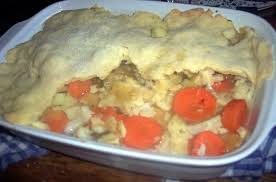A good source of information on living on short rations is to study the way the English cooked during World War 2. Due to rationing many foods were in extremely short supply. I was born in England during the war and have heard many stories about rationing. Even after the war, many items were in short supply into the mid 1950’s.
Many of their recipes were very heavy in vegetables, since they were more available. An example would be Lord Woolton Pie a recipe that the government suggested.
Woolton Pie – A garden recipe
This recipe became famous in England during World War II rationing. Lord Woolton, Minister for Food, promoted it as a healthy meal choice.
Food, promoted it as a healthy meal choice.
Ingredients for the pie:
- One lb (450g) of dices potatoes
- One lb (450g) cauliflower
- One lb (450g) rutabagas
- One lb (450g) carrots
- Three or four spring onions or some sliced onion
- One teaspoonful of vegetable extract or bouillon cube;
- One tablespoon of oatmeal
- Chopped parsley
Ingredients for the pastry:
This pastry uses only flour and lard (no sugar or egg) for six oz (170g) of pastry
- Four oz (113.4g) of whole-wheat flour
- Two oz (56.7g) lard
Instructions for the pie:
Dice up the vegetables. Place in a saucepan with just enough water to cover. Add the oatmeal and vegetable extract and stir. Cook for ten to fifteen minutes. Stir occasionally to prevent the mixture from sticking. Remove any excess water and allow cooling. Put the vegetables into a pie dish and sprinkle with chopped parsley.
Instructions for the pastry:
Place the flour into a bowl. Cut up the lard and rub into the flour with your fingertips until you have a breadcrumb like consistency. Add a tablespoon of water to make dough. Roll out very thinly. Cover the vegetables with the whole-wheat pastry. Bake in a moderate oven until the pastry is nicely browned and serve hot.
As an option some people would put melted cheese on top if it was available.
Now you can see this is not the type of food we are used too. In England during this period, meat was in very short supply. Most went to the military. As a result, people lived on lots of vegetables and grains plus fish was often available. Tomorrow I will show what an individual would get while rationing was in effect.
Howard



Suprisingly, no beans. I too was born during WW II but in the U.S. My family was poor and we often had meatless meals or almost meatless. But beans and lentils would give the meal some substance. Even a piece of bacon fat would find it’s way into the baked bean pot for flavor. Were there no beans available in England after the war?
My ancestry is English, my mother cooked English style. You ever eat a hamburger that was crunchy? You think gravy is water pored into the pan that cooked that meat? I remember about twenty years ago when it was a news story that the first large London hotel had actually hired an English cook. All I can say is English cooking is so bad starvation is a reasonable alternative. Yorkshire pudding is a carp ball. And their Beer is warm, flat, and stale. The thought of English cooking makes me want to cower n a ball and shiver
Some of the well known English dishes are a bit “off”, like kidney pie. But I myself have made Yorkshire pudding and it is awesome. Many of the steak houses in the U.S. and Canada will serve Yorkshire pudding with a meal and it is really good.
British cooking has come a long way from the rationing of the war, rationing didn’t end until 1953.
I am an Englishman born and bred and proud of it.
Would you believe, I’m a huge fan of British foods! Love pasties, HP sauce, bangers and mash, you name it! In fact, my family took me to a local pub for my birthday just a few weeks ago!